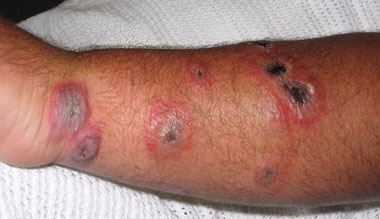
Possible Anthrax outbreak in Meru. 2 dead, 9 others admitted at Muthara Sub-County Hospital, however there is little knowledge about the disease.
Anthrax is a life-threatening infectious disease caused by Bacillus anthracis that normally affects animals, especially ruminants (such as goats, cattle, sheep, and horses).
Anthrax can be transmitted to humans by contact with infected animals or their products.Usually, anthrax bacteria enter the body through a wound in the skin. You can also become infected by eating contaminated meat or inhaling the spores.

Signs and symptoms, which depend on how you’re infected, can range from skin sores to vomiting to shock. Prompt treatment with antibiotics can cure most anthrax infections. Inhaled anthrax is more difficult to treat and can be fatal.
Symptoms
There are four common routes of anthrax infection, each with different signs and symptoms. In most cases, symptoms develop within seven days of exposure to the bacteria. The one exception is inhalation anthrax.
After exposure to inhalation anthrax, it may take weeks before symptoms appear.

Cutaneous anthrax
A cutaneous anthrax infection enters your body through a cut or other sore on your skin.
It’s by far the most common route the disease takes. It’s also the mildest with appropriate treatment, cutaneous anthrax is seldom fatal. Signs and symptoms of cutaneous anthrax include:
- A raised, itchy bump resembling an insect bite that quickly develops into a painless sore with a black center.
- Swelling in the sore and nearby lymph glands
Gastrointestinal anthrax
This form of anthrax infection begins by eating undercooked meat from an infected animal. Signs and symptoms include:
- Nausea
- Vomiting
- Abdominal pain
- Headache
- Loss of appetite
- Fever
- Swollen neck

Inhalation (pulmonary) anthrax
Inhalation anthrax develops when you breathe in anthrax spores. It’s the most deadly way to contract the disease, and even with treatment, it is often fatal. Initial signs and symptoms of inhalation anthrax include:
- Mild chest discomfort
- Flu-like symptoms, such as sore throat, mild fever, fatigue and muscle aches, which may last a few hours or days .
- Shortness of breath
- Coughing up blood
- Painful swallowing
How you can prevent Anthrax
Antibiotics are recommended to prevent infection in anyone exposed to the spores. Ciprofloxacin (Cipro), doxycycline (Monodox, Vibramycin, others) and levofloxacin (Levaquin) are approved by the Food and Drug Administration for post-exposure prevention of anthrax in adults and children.
Anthrax vaccine
An anthrax vaccine for humans is available. The vaccine doesn’t contain live bacteria and can’t lead to infection, but it can cause side effects, ranging from soreness at the injection site to more-serious allergic reactions.
The vaccine isn’t intended for the general public. Instead, it’s reserved for military personnel, scientists working with anthrax and people in other high-risk professions.
Avoiding infected animals
If you live or travel in a country where anthrax is common and herd animals aren’t routinely vaccinated, avoid contact with livestock and animal skins as much as possible. Also avoid eating meat that hasn’t been properly cooked.
Even in developed countries, it’s important to handle any dead animal with care and to take precautions when working with or processing imported hides, fur or wool.